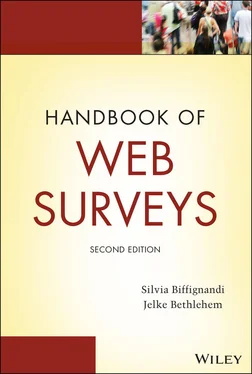2 Chapter 2 Figure 2.1 Questions with Likert scales Figure 2.2 A matrix question
3 Chapter 3 Figure 3.1 Flowchart of a probability‐based web‐only or mobile web survey... Figure 3.2 Sub‐steps for deciding the mode of data collection Figure 3.3 Error message for a compulsory question in the Nutrition & Health... Figure 3.4 Question asking for percentage: error message Figure 3.5 Message for asking answer to a compulsory question: smartphone de...
4 Chapter 4 Figure 4.1 Generalizing from a sample to a population Figure 4.2 Target population and sampling frame Figure 4.3 Random samples from the working population of SamploniaFigure 4.4 Comparing the sample mean with the regression estimatorFigure 4.5 The relationship between the value of stolen goods and floor spac...Figure 4.6 The distribution of the sample mean of the value of stolen goods ...Figure 4.7 Distribution of the estimator of the value of stolen goods for si...Figure 4.8 Distribution of the estimator of the value of stolen goods for si...Figure 4.9 Distribution of the ratio, regression, and post‐stratification es...
5 Chapter 5Figure 5.1 The bias and precision of an estimatorFigure 5.2 A classification of survey errorsFigure 5.3 A closed question with radio buttonsFigure 5.4 A closed question with two columns of radio buttonsFigure 5.5 A closed question with a drop‐down boxFigure 5.6 A drop‐down box with a fixed number of itemsFigure 5.7 An example of a matrix questionFigure 5.8 An example of a matrix question with straight‐liningFigure 5.9 Question about the 1998 electricity lawFigure 5.10 A check‐all‐that‐apply questionFigure 5.11 A check‐all‐that‐apply question with forced choice...Figure 5.12 The question‐based approachFigure 5.13 The form‐based approachFigure 5.14 Formatting a date questionFigure 5.15 Formatting an open questionFigure 5.16 A recall questionFigure 5.17 A context‐sensitive questionFigure 5.18 Questions containing additional informationFigure 5.19 Relationship between target variable, response behavior, and aux...Figure 5.20 Nonresponse in the recruitment phase of the LISS panelFigure 5.21 Response in SM4 to the question “I feel at home with the people ...
6 Chapter 6Figure 6.1 A questionnaire definition in BlaiseFigure 6.2 The paper version of the questionnaireFigure 6.3 The data entry programFigure 6.4 The computer‐assisted interviewing programFigure 6.5 A detected consistency errorFigure 6.6 Web survey question
7 Chapter 7Figure 7.1 Using a unique code to get access to the questionnaire.Figure 7.2 A question of the survey and the page number.Figure 7.3 The progress indicator of the radio listening surveyFigure 7.4 Closed questionFigure 7.5 Open questionFigure 7.6 A hybrid questionFigure 7.7 Stressing the importance of a filter question with a frame.Figure 7.8 Helping the respondent to record values in the proper unit of mea...Figure 7.9 A mobile phone survey question (study 1)Figure 7.10 Questions for the Mandarina mobile phone (study 2)Figure 7.11 Questions for the Nokia mobile phone (study 2)Figure 7.12 A closed question in its initial stateFigure 7.13 A closed question after selecting an answerFigure 7.14 A closed question after selecting another answerFigure 7.15 A closed question with nested answersFigure 7.16 A Likert scale questionFigure 7.17 A Likert scale question with horizontal categoriesFigure 7.18 Likert scale questions with numbered and labeled categoriesFigure 7.19 Adding an extra option to a Likert scale questionFigure 7.20 Including non‐substantive optionsFigure 7.21 A three‐item scale question on a tablet or computer browser...Figure 7.22 A three‐item scale question on a smartphoneFigure 7.23 A drop‐down box in its initial stateFigure 7.24 A drop‐down box after opening the listFigure 7.25 A check‐all‐that‐apply questionFigure 7.26 A check‐all‐that‐apply question with radio buttons...Figure 7.27 Formatting an open questionFigure 7.28 Combining an open and a closed questionFigure 7.29 A screen of the Structural Business SurveysFigure 7.30 Blaise audit trail data imported in SPSSFigure 7.31 Theory of planned behaviorFigure 7.32 A matrix question in the Consumers' Values Survey
8 Chapter 8Figure 8.1 Data collection phasesFigure 8.2 Boxplots of the response rate, R‐indicator, and costs per respond...Figure 8.3 Optimal response rates (lower line) and R‐indicator (upper line) ...Figure 8.4 Boxplots of the response rate, costs per respondent, and R‐indica...
9 Chapter 9Figure 9.1 Concurrent mixed‐mode data collectionFigure 9.2 Sequential mixed‐mode data collectionFigure 9.3 The mixed‐mode design of the Safety MonitorFigure 9.4 Mixed‐mode design of the manufacturing sector surveyFigure 9.5 Response by mode in the SCI survey
10 Chapter 10Figure 10.1 The target population and the sampling frameFigure 10.2 Internet access by households in the European Union in 2018Figure 10.3 Percentage of individuals Internet access (last three months) by...Figure 10.4 Percentage of individuals Internet access (daily access) by age ...Figure 10.5 The confidence level of the 95% confidence interval as a functio...Figure 10.6 Relationships between variablesFigure 10.7 Results of the simulations for variable NEP (National Elderly Pa...Figure 10.8 Results of the simulations for variable NIP (New Internet Party)
11 Chapter 11Figure 11.1 The difference between the polls and the election for Donald Tru...Figure 11.2 The confidence level of the 95% confidence interval as a functio...Figure 11.3 Relationships between variablesFigure 11.4 Results of the simulations for variable NEP (National Elderly Pa...Figure 11.5 Results of the simulations for variable NIP (New Internet Party)Figure 11.6 Opponents of shopping Sundays by mode of data collection (percen...
12 Chapter 12Figure 12.1 Estimating the percentage voters for the NEP in case of nonrespo...Figure 12.2 Estimating the percentage voters for the NIP in case of nonrespo...Figure 12.3 Estimating the percentage voters for the NEP in case of under‐co...Figure 12.4 Estimating the percentage voters for the NIP in case of under‐co...Figure 12.5 Estimating the percentage voters for the NEP in case of self‐sel...Figure 12.6 Estimating the percentage voters for the NIP in case of self‐sel...Figure 12.7 Estimating the percentage voters for the NEP in case of selectio...Figure 12.8 Estimating the percentage voters for the NEP in case of under‐co...Figure 12.9 Estimating the percentage voters for the NIP in case of under‐co...Figure 12.10 Estimating the percentage voters for the NEP in case of self‐se...Figure 12.11 Estimating the percentage voters for the NIP in case of self‐se...
13 Chapter 13Figure 13.1 The logit and probit link functionsFigure 13.2 The distribution of the estimated response propensitiesFigure 13.3 Response propensity stratification with 5 strataFigure 13.4 Response propensity stratification with 25 strataFigure 13.5 Response probabilities for non‐web usersFigure 13.6 Response probabilities for web usersFigure 13.7 Estimated propensity scores for web survey participants
14 Chapter 14Figure 14.1 The polling disaster in the United Kingdom on 7 May, 2015
1 Cover Page
2 Title Page Handbook of Web Surveys Second Edition Silvia Biffignandi University of Bergamo Italy Jelke Bethlehem Faculty of Social and Behavioral Sciences, Institute of Political Science Leiden University The Netherlands contact: biffisil@teletu.it j.g.bethlehem@fsw.leidenuniv.nl website: www.web-survey-handbook.com/
3 Copyright
4 Preface
5 Table of Contents
6 Begin Reading
7 Index
8 Wiley End User License Agreement
1 iii
2 xi
3 xii
4 xiii
5 xiv
6 xv
7 1
8 2
9 3
10 4
11 5
12 6
13 7
14 8
Читать дальше












